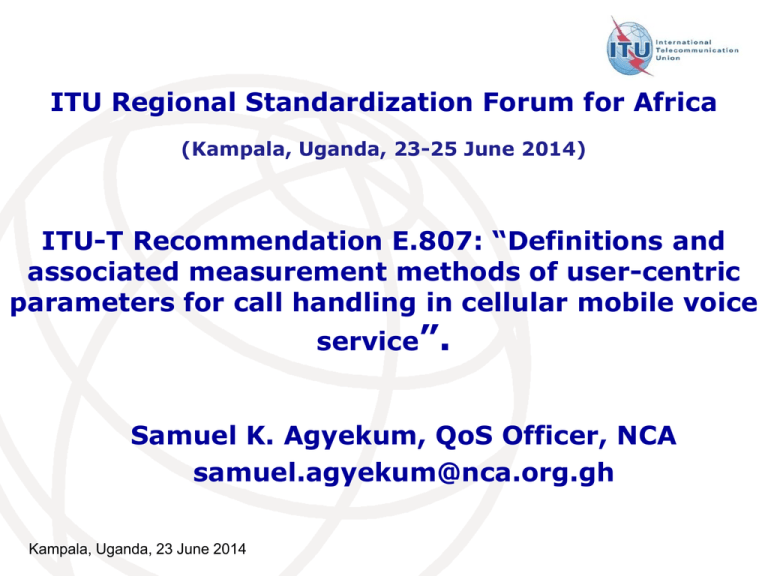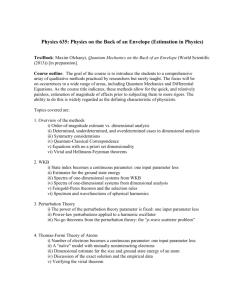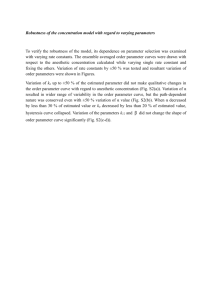Presentation
advertisement

ITU Regional Standardization Forum for Africa (Kampala, Uganda, 23-25 June 2014) ITU-T Recommendation E.807: “Definitions and associated measurement methods of user-centric parameters for call handling in cellular mobile voice service”. Samuel K. Agyekum, QoS Officer, NCA samuel.agyekum@nca.org.gh Kampala, Uganda, 23 June 2014 Presentation Outline Introducing E.807 “Definitions, associated measurement methods and guidance targets of user-centric parameters for call handling in cellular mobile voice service” Scope of E.807 QoE Parameter Definitions Test Methodology Measurement Profile Explanation on Parameter Definitions, Equations, Targets Network-QoE parameter Relationship Matrix Conclusion Kampala, Uganda, 23 June 2014 2 Introducing E.807 Call handling is an important aspect of Cellular mobile voice service user experience which is executed end-to-end by the Access and Non Access Stratum of the network (i.e GSM, CDMA or UMTS) To enable Regulators and Operators measure Call Handling of Cellular Mobile Voice Service for benchmarking and compliance, the document defines five parameters, describes the methodology in accessing them as well as provides some guidance targets Kampala, Uganda, 23 June 2014 3 Scope of E.807 The recommendation provides an expose into call handling in Cellular mobile Voice service systems but most importantly relates signaling procedures to major key performance indicators used in the assessment of voice service handling. Some causative factors that incapacitate mobile networks not to perform at their desired levels in consonance with meeting minimum communication standards in respect of guidance targets are discussed herein. Kampala, Uganda, 23 June 2014 4 QoE Parameter definitions Parameter 1: Call Setup Time or Voice Service Access Time Parameter 1 is the period of time elapsing from the sending of a complete destination address (target telephone number) to the setting up of a call to the receiving terminal. Parameter 2: Stand-alone Dedicated Control Channel (SDCCH) or Radio Resource Control Congestion Rate Parameter 2 is defined as the probability of failure of accessing a stand-alone dedicated control or radio resource control channel during call set up. Kampala, Uganda, 23 June 2014 5 QoE Parameter definitions Parameter 3: Traffic Channel Congestion Rate or Voice Service Non-Accessibility Ratio Parameter 3 is defined as the probability of failure of accessing traffic channel(s) or radio access bearers during call connections. Parameter 4: Call Drop Rate or Voice Service Cut-Off Ratio Parameter 4 is the probability of a call terminating without any of the users’ will. Kampala, Uganda, 23 June 2014 6 QoE Parameter definitions Parameter 5: Call Completion Rate or Voice Service Retainability Ratio Parameter 5 is defined as the probability that a call has, after being successfully set up, to be maintained during a period of time, ending normally, i.e., according to the user’s will. Kampala, Uganda, 23 June 2014 7 Test Methodology The test methodology is based on three basic characteristics: End-to-End Measurements Impartiality Objectivity Kampala, Uganda, 23 June 2014 8 Measurement Profile Voice calls are performed in series of 2 attempts within 10 seconds for a delay of 10 seconds between series. A successful call is to last a maximum of 60 seconds and has to be completed in a window of 90 seconds. The minimum time required for a call set up before the end of a call window is 30 seconds. The maximum call set up time is 30 seconds Kampala, Uganda, 23 June 2014 9 Measurement Profile Guard interval of 10 seconds are calibrated to ensure effective call clearing. The relationship between Mobile Originating Calls (MOC) and Mobile Terminating Calls (MTC) is 1:1 Kampala, Uganda, 23 June 2014 10 Explanations on Parameter Definitions, Equations & Targets Layer 3 Markers Equations Guidance Targets Call Setup Time “A1” is the time when the MS sends a Channel Request message. “A2” is the time when the MS receives the Alerting message from the MSC = talert signal taddress-sending 95 percent of calls connected < 10.00 sec SDCCH Congestion •No Layer 3 <<CC: Setup>> within 30s •a Layer 3<<CC: Channel Release>> =No. of Connect fails due to Imm. Ass Failures/ MOC Attempts * 100 [GSM] =No. of Connect fails due to RRC Setup Failures/ MOC Setup Failed Calls < 1% Explanations on Parameter Definitions, Equations & Targets Layer 3 Markers Equations Guidance Targets TCH Congestion No Layer 3 <<CC: Connect Acknowledge>> within 30s after sending a Layer 3 <<CC: Setup>> OR a Layer 3 <<CC: Release>> [GSM] [CDMA] OR a Layer 3 <<CC: RRC Connection Release>> OR a Layer 3<<CC: Channel Release>> [UMTS] =No. of Connect fails due to Assignment Failures/ MOC Attempts * 100 [GSM] [CDMA] =No. of Connect fails due to RAB Setup Failures/ MOC Attempts *100 [UMTS] Connect Failed Calls < 1% Call Drop Rate Phone goes into Idle Mode (Layer 3<<RR: System Information 3>> OR Layer 3 <<Idle Report>> OR Layer 3<<CC:DL Disconnect>> =Number of Calls terminated unwillingly/ MOC Attempts or Successful MOC Attempts * 100 [Regulatory Analysis] Dropped Calls < 3% Explanations on Parameter Definitions, Equations & Targets Call Completion Rate Layer 3 Markers Equations Guidance Targets Only call attempts that had Layer 3 message <<CC: UL Disconnect>> or << RRC Connection Release Complete >> are considered = Number of Normally ended calls/ MOC Attempts * 100 Not less than 70% Network-QoE Parameter Relationship Matrix Network Factors Call Setup Time Poor Coverage Network Interference Hardware & Transmission Faults Insufficient Signaling Resources Improper Parameter Configuration Routing TRX Imbalance of UL & DL Paths SDCCH TCH Call Drop Congestion Congestion Rate Conclusion This recommendation seeks to provide step-bystep signaling procedures required in originating and terminating a voice call; more so indicating important Layer 3 reference points used in analyzing the five user-centric parameters afore-discussed. Also, a relationship has been established between network performance and voice service quality.






